According to the North American Consensus on Hydrogen and Methane-Based Breath Testing in Gastrointestinal Disorders, breath testing “is a useful, inexpensive, simple and safe diagnostic test in the evaluation of common gastroenterology problems,” including small intestinal bacterial overgrowth (SIBO), irritable bowel syndrome (IBS), carbohydrate maldigestion and dysfunction or alterations in oro-cecal transit.
The American College of Gastroenterology’s Clinical Guidelines for SIBO also suggest the use of breath testing (either glucose hydrogen or lactulose hydrogen) for the diagnosis of SIBO in 1) patients with IBS, 2) symptomatic patients with suspected motility disorders or 3) symptomatic patients with previous luminal abdominal surgery.
Based on the North American Consensus’ statements on interpretation of breath testing results, here are 6 common patient results of SIBO hydrogen and methane breath tests and their respective indications:
Common “Supported” Results
High Hydrogen/No Methane
Patients who have symptoms such as bloating often will have high hydrogen production that increases dramatically throughout the test. Notice that the plot crosses the dashed line at 20 ppm, which indicates a “supported” (positive) result for hydrogen.

No Hydrogen/High Methane
Patients who have symptoms such as constipation often will have high methane production that is present at high levels during the entire length of the test. Notice that the plot is above the dotted line at 10 ppm, which indicates a “supported” (positive) result for methane.
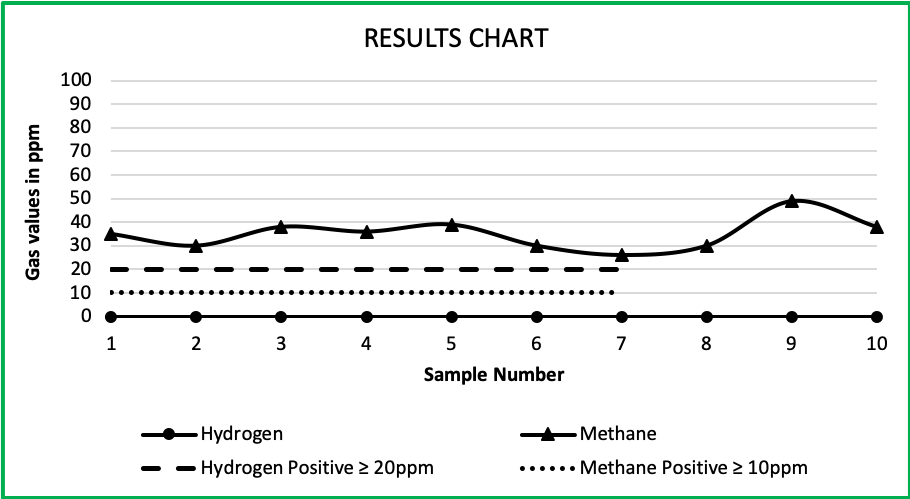
High Hydrogen/High Methane
Patients who produce both methane and hydrogen often demonstrate this plot. This is due to the competing methanogens consuming the hydrogen gas to produce methane gas. The decrease in hydrogen with the increase in methane is indicative of this microbiome composition. This test would be a “supported” (positive) result for both hydrogen and methane.
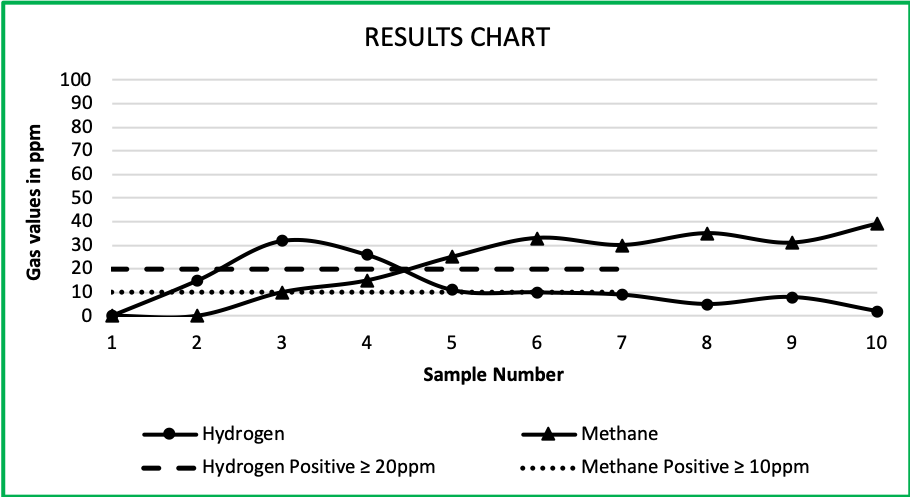
Common “Not Supported” Results
Low Hydrogen/Low Methane (Not Supported)
Patients who have GI-related symptoms that do not produce enough gas to surpass the clinical cutoff of either hydrogen (>20 ppm) or methane (>10 ppm) at or before 90 minutes (sample 7) often have this trend. Notice that the two plots do not cross either the dashed line for hydrogen or the dotted line for methane, which indicates the test would be a “not supported” result for either gas production.
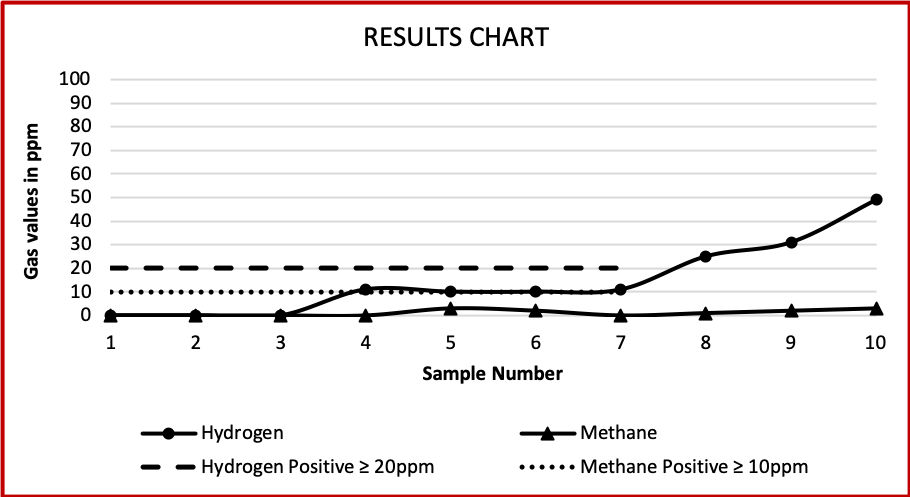
No Hydrogen/No Methane “Flatline Result” (Not Supported)
Patients that do not produce any hydrogen or methane throughout the entire test, but still present with GI-related symptoms, often have this plot. This may be due to hydrogen sulfide production from sulfur-reducing bacteria, which a hydrogen and methane breath test cannot detect. This test would be a “not supported” result for either gas. CDI is working with the research community to assess future modalities for diagnostic testing for H2S (hydrogen sulfide).
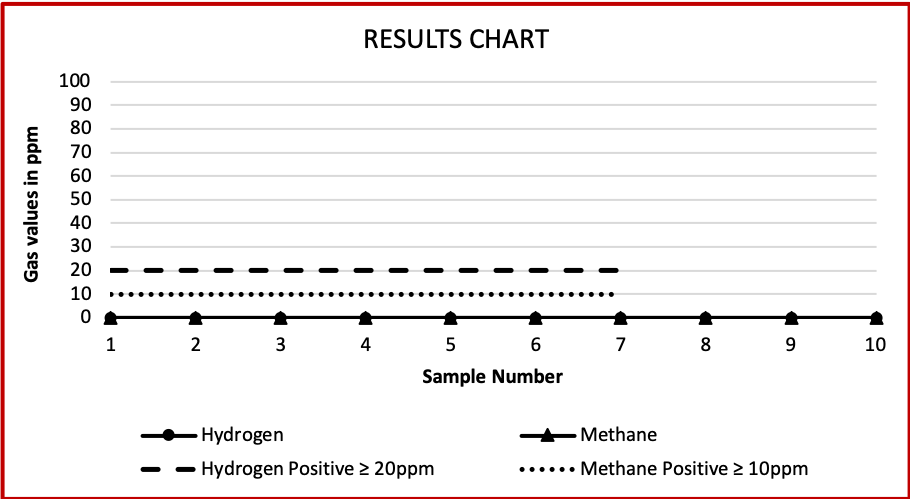
High Hydrogen Baseline (Not Supported)
Patients who do not fast properly will often have a plot line that looks like this. The first few samples will begin with high hydrogen levels, slightly increase, and then immediately decrease. The patient is recommended to retest when this occurs, this test would be a “not supported” result for either gas.
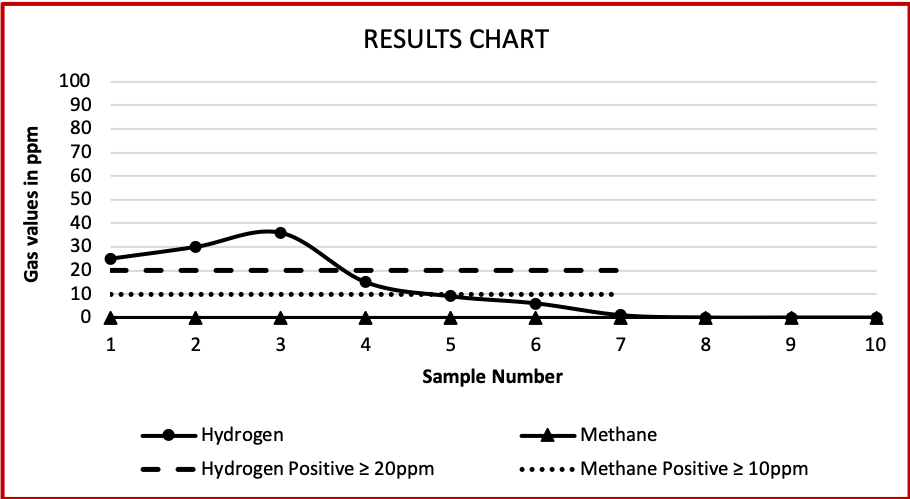
Invalid Breath Test Notification
Invalid Breath Test results mean that CDI was not able to provide a valid result. CDI may not know that a test is invalid until it is fully processed by the lab. It’s important to note that failure to follow the Instructions For Use can lead to an invalid test result, and the patient may still be billed for the test if the test is invalid due to patient error. Read more about Invalid Breath Test Results.
Commonwealth Diagnostics International, Inc. (CDI) is the only medical diagnostics company that meets the American College of Gastroenterology’s Clinical Guidelines for SIBO as well as the North American Consensus for hydrogen and methane-based breath testing in gastrointestinal disorders. The common test results above are guidelines only and should be correlated with clinical information that is unavailable to CDI.
Healthcare providers should assess each patient’s clinical factors that may affect the interpretation of the test results and ensure that the test results correlate with the patient’s symptoms and other related findings for diagnostic and treatment purposes.
Click here to learn more about CDI’s non-invasive at-home breath tests or to place a collection kit order.

